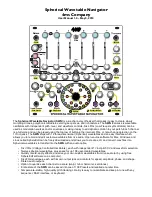
VOICE COMMON
7
AFTER TOUCH (Amplitude & Pitch Modulation, Pitch & Level Control)
VC>AFTER TOUCH
AM=on
PM=on
->
Summary: Assigns keyboard after-touch to ampli-
tude modulation, pitch modulation,
pitch
control, or level control — or any combination
of the above.
Settings: AM (Amplitude Modulation): off, on
PM (Pitch Modulation): off, on
Pit (Pitch Control): –12 … 0 … +12 max.*
Lev (Level Control): off, on
Procedure: Use the [
4
] and [
6
] cursor keys to place
the underline cursor under the AM, PM, Pit, or
Lev parameter. The arrows at either end of the
display mean that more parameters can be
accessed by scrolling in the indicated direction.
Use the [–1/NO] and [+1/YES] keys to turn the
AM, PM, and/or Lev parameter on or off, or to
select the desired Pit control range.
Details: As with the modulation wheel, amplitude
modulation produces a tremolo effect while
pitch modulation produced a vibrato effect. The
harder you press a key, the deeper the
modulation. This is only an “off/on” switch,
however,
and
the
maximum
depth
of
modulation to be applied must be set using the
LFO AM Depth and PM Depth parameters in
the ELEMENT TONE edit mode.
When after touch is assigned to amplitude or
pitch modulation, LFO modulation can only be
applied via after touch.
The Pit parameter allows keyboard after touch
to be used for note bending. The greater the key
pressure the greater the amount of pitch bend.
Positive values produce an upward bend when
key pressure is applied, and minus values pro-
duce a downward bend. Each increment from
represents a semitone. A setting of “ 0 ” pro-
duces no pitch bend. A setting of “12” allows a
maximum upward pitch bend of one octave,
while a setting of “ – 4 ” allows a maximum
downward pitch bend of a major third.
When the Lev parameter is turned on it becomes
possible to control the level of the sound over a
limited range by keyboard after touch. The
amount and direction (i.e. an increase or de-
crease) of level change depends on the setting of
the AFTER TOUCH SENSITIVITY parameter
in the ELEMENT TONE edit mode.
If both WHEEL and AFTER TOUCH are as-
signed to modulation control, the controller via
which the highest modulation level is applied
will take priority when both are used simul-
taneously.
*
This range may be more limited in some cases.
An exclamation mark (!) will appear after the
range value when the limit is reached.
ENVELOPE (Attack & Release Rates)
VC>ENVELOPE
AR=
0
RR=
0
Summary: Sets the overall attack and release rates
for the current voice.
Settings: AR (Attack Rate): –99 … 0 … +99 max.*
RR (Release Rate): –99 … 0 … +99 max.*
Procedure: Use the [
4
] and [
6
] cursor keys to place
the underline cursor under the AR or RR
parameter. Use the [–1/NO] and [+1/YES] keys
to set the selected parameter as required.
Details: Although much more detailed envelope
programming
capability
is
available
for
individual
elements
(see
the
ELEMENT
ENVELOPE edit mode), these functions provide
an easy way to adjust the most important
envelope parameters for the overall voice.
Positive values produce a faster attack or release
time, while negative values produce a slower
attack or release time. You might want to
lengthen the release time of a voice, for
example, to produce a lingering sustain effect
after you release the keys.
Содержание SY-35
Страница 1: ......
Страница 2: ......
Страница 3: ......
Страница 6: ...VOICE COMMON 1 Feature Reference Manual...
Страница 7: ...VOICE COMMON 2...
Страница 9: ......
Страница 15: ......
Страница 29: ...ELEMENT TONE 24...
Страница 35: ......
Страница 36: ......
Страница 37: ...ELEMENT ENVELOPE 32...
Страница 39: ......
Страница 45: ......
Страница 51: ...UTILITY SETUP 46...
Страница 53: ......
Страница 55: ...UTILITY RECALL 50...
Страница 57: ......
Страница 62: ...APPENDIX 57 APPENDIX...
Страница 63: ...APPENDIX 58...
Страница 70: ......
Страница 75: ......
Страница 76: ......
Страница 77: ......
Страница 78: ......
Страница 79: ......
Страница 80: ......
Страница 81: ......
Страница 82: ......
Страница 83: ......












































